新概念英语第一册Lesson 1 Excuse me !课件(共32张PPT)
文档属性
| 名称 | 新概念英语第一册Lesson 1 Excuse me !课件(共32张PPT) | 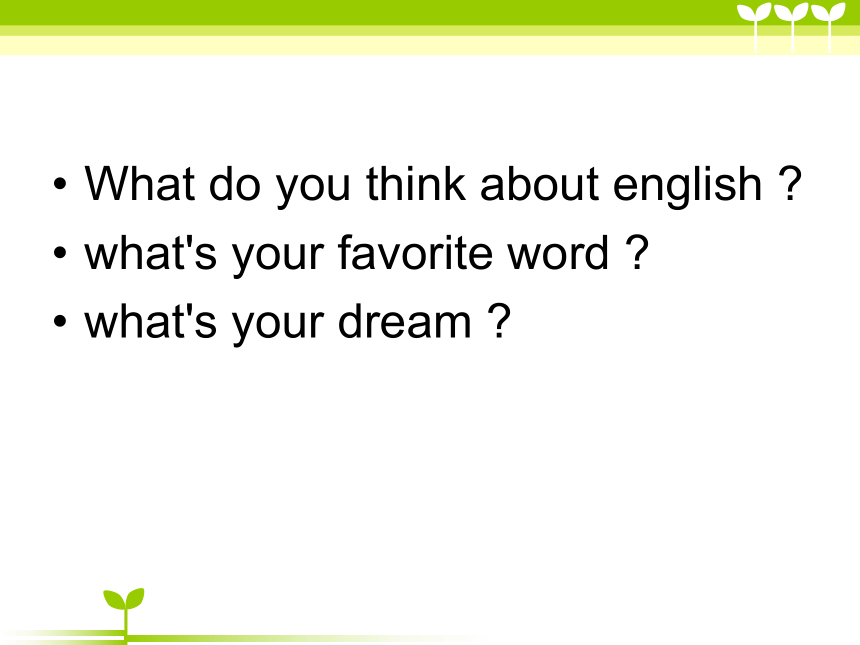 | |
| 格式 | pptx | ||
| 文件大小 | 2.6MB | ||
| 资源类型 | 教案 | ||
| 版本资源 | 新概念英语 | ||
| 科目 | 英语 | ||
| 更新时间 | 2024-05-10 18:58:14 | ||
图片预览

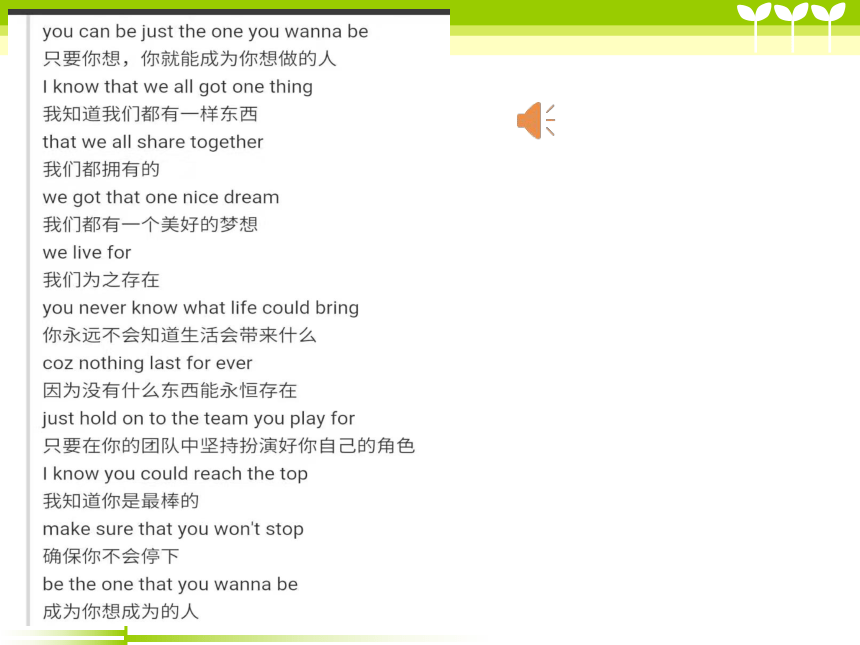
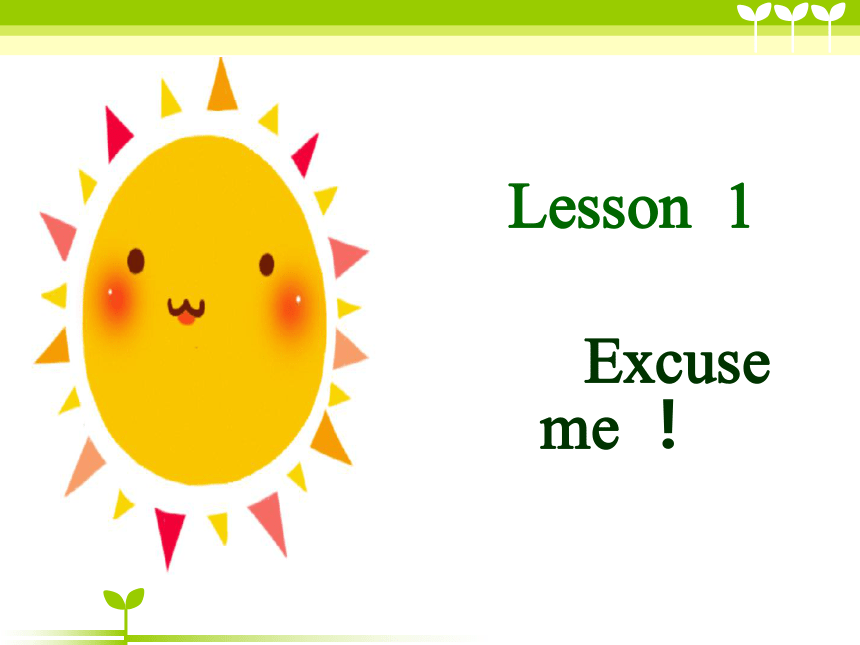
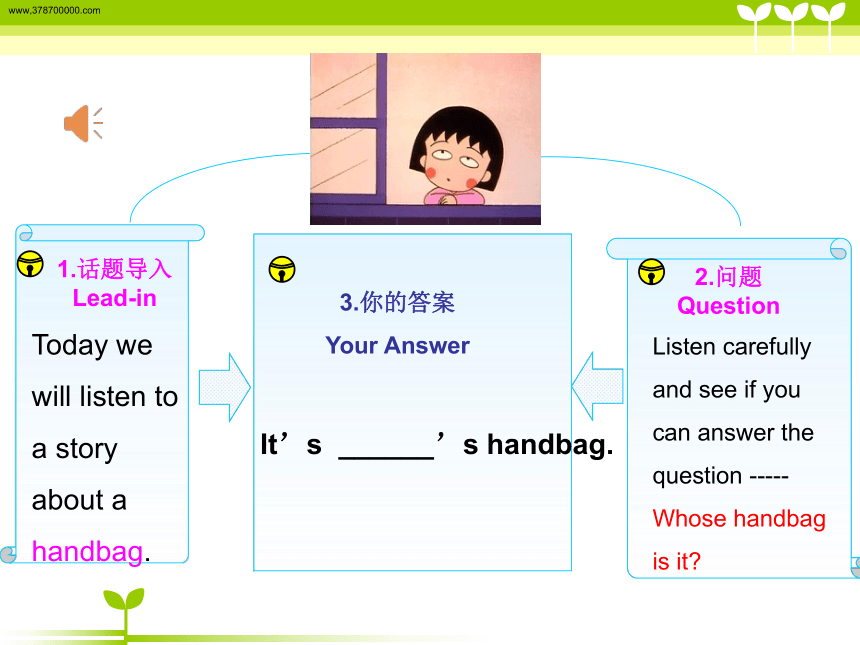
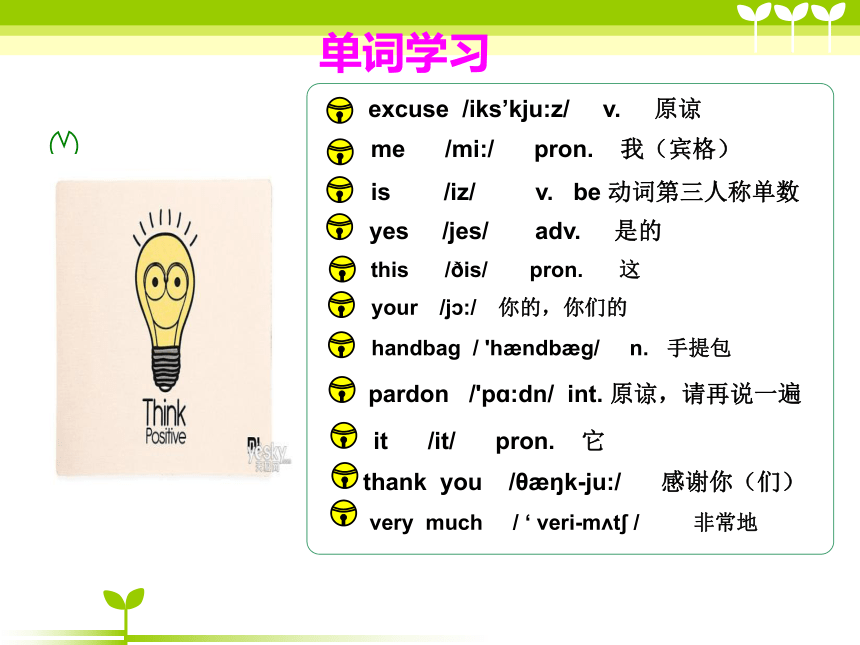
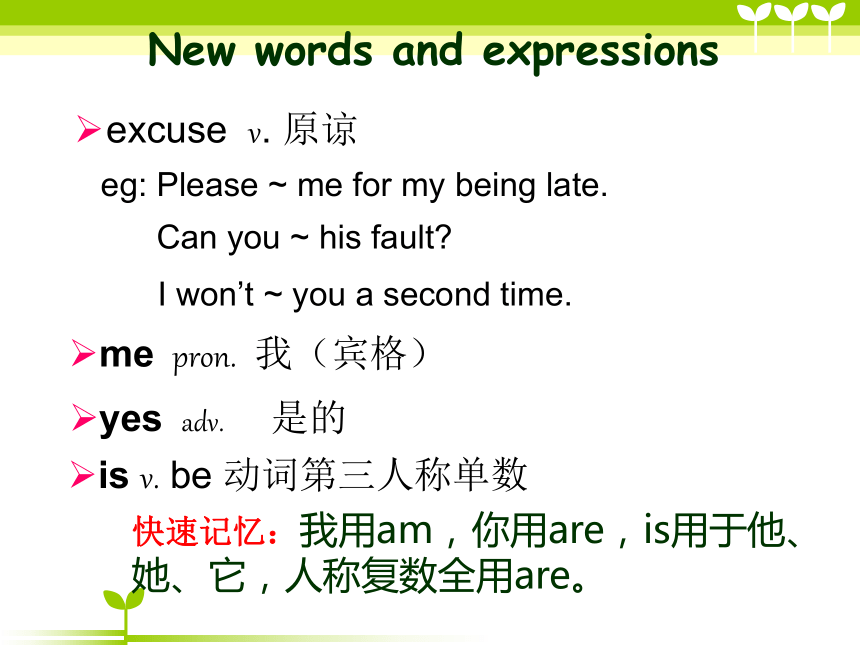
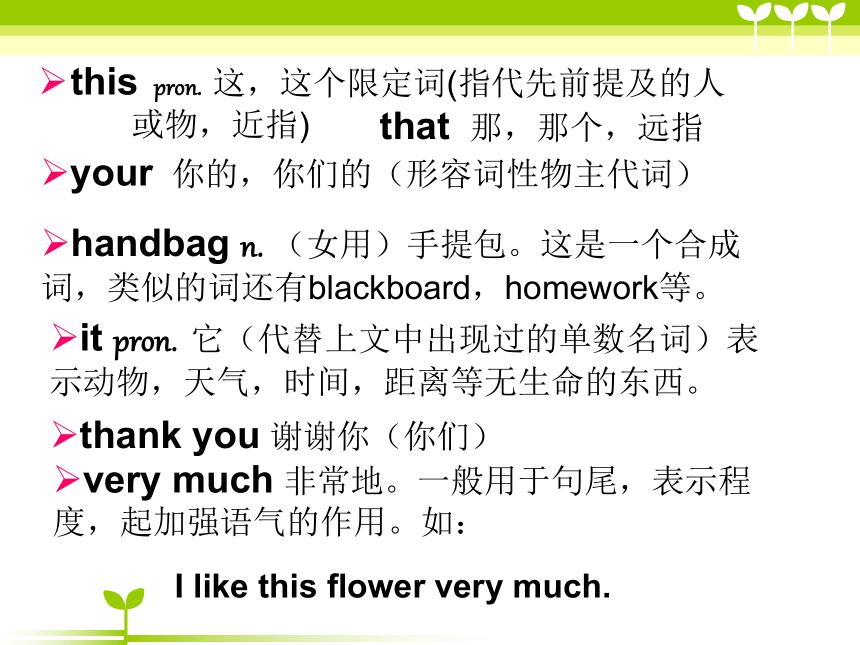
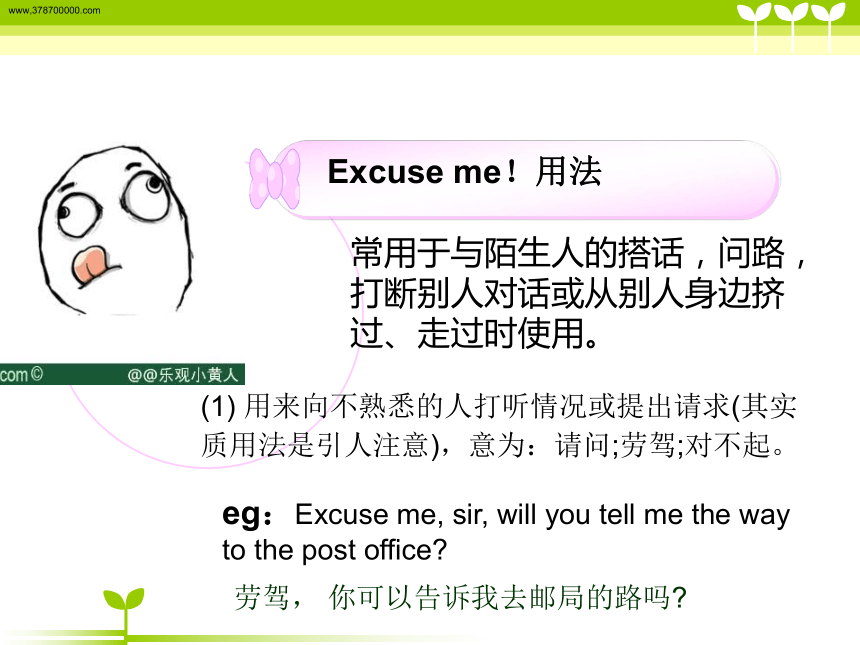
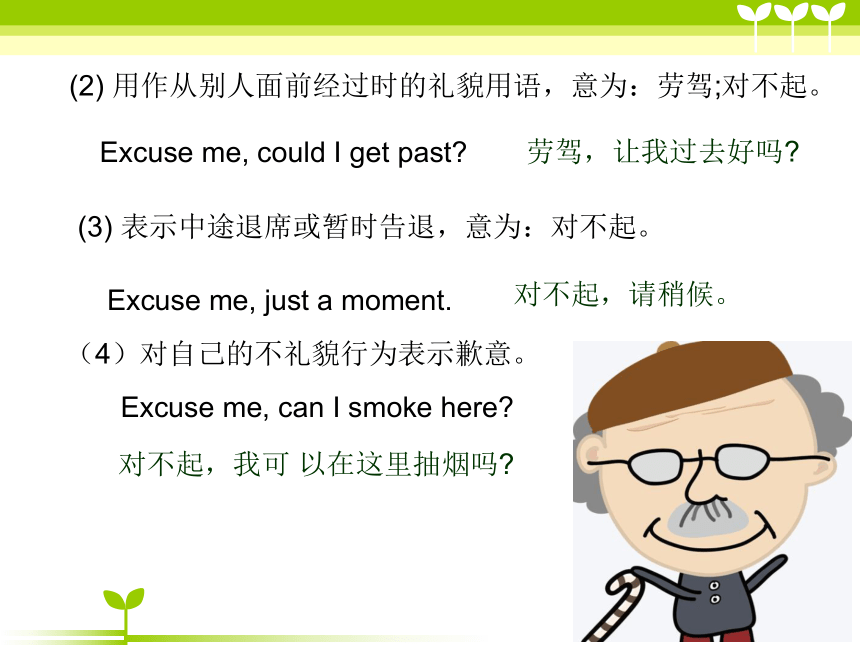
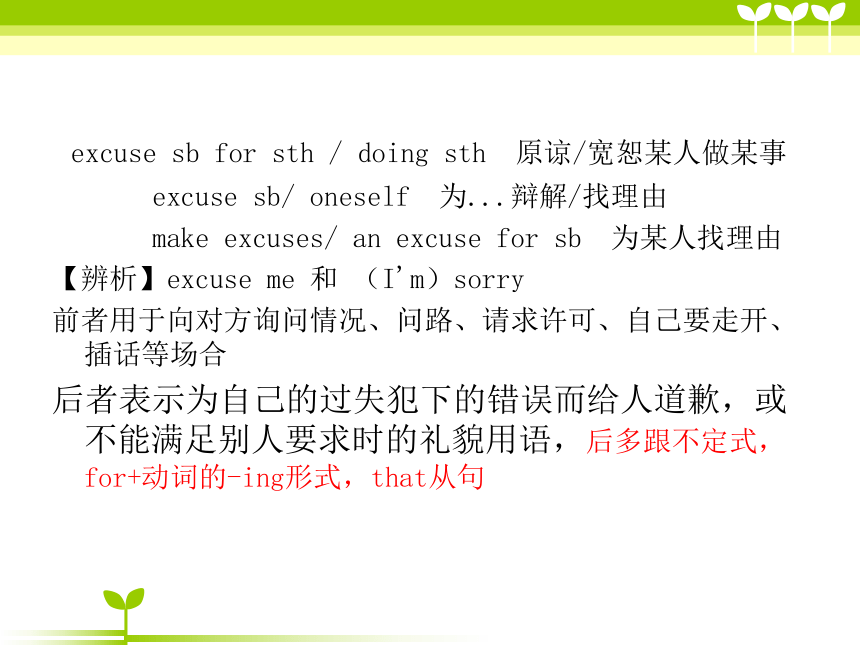
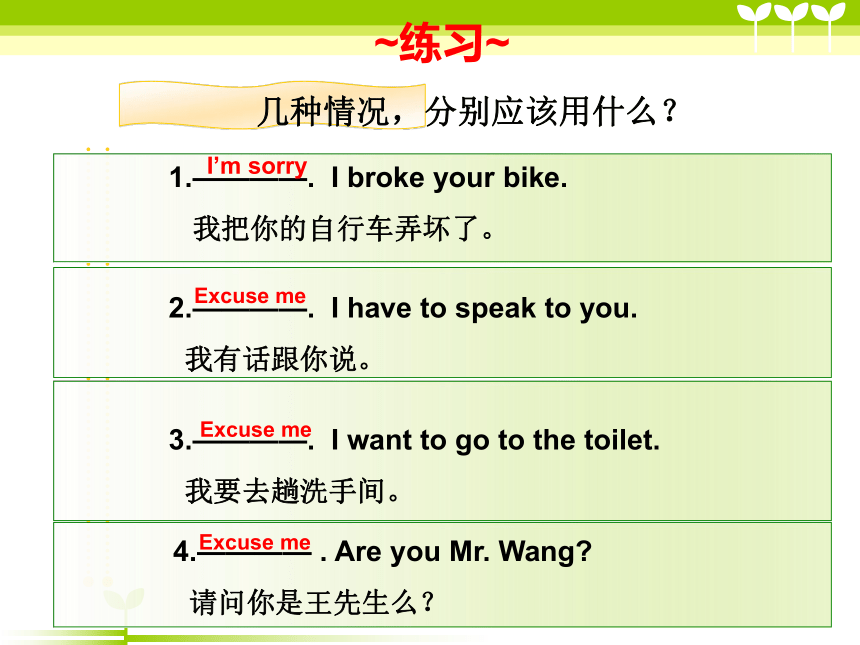
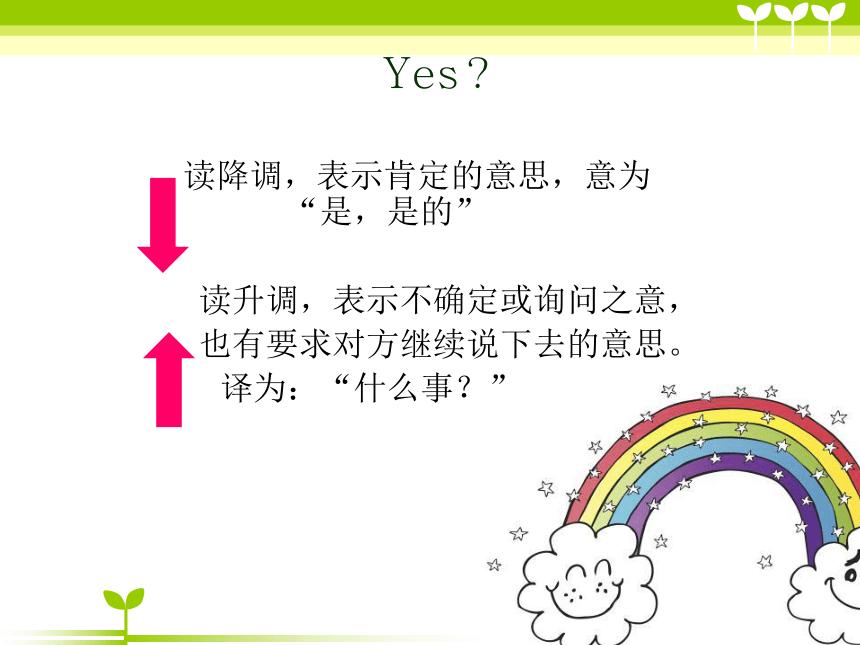
文档简介
(共32张PPT)
What do you think about english
what's your favorite word
what's your dream
Lesson 1
Excuse me !
1.话题导入Lead-in
3.你的答案
Your Answer
2.问题Question
Today we will listen to a story about a handbag.
Listen carefully and see if you can answer the question -----
Whose handbag is it
It’s ______’s handbag.
www,
单词学习
excuse /iks’kju:z/ v. 原谅
me /mi:/ pron. 我(宾格)
is /iz/ v. be 动词第三人称单数
yes /jes/ adv. 是的
this / is/ pron. 这
your /j :/ 你的,你们的
handbag / 'h ndb g/ n. 手提包
pardon /'pɑ:dn/ int. 原谅,请再说一遍
it /it/ pron. 它
thank you /θ k-ju:/ 感谢你(们)
very much / ‘ veri-m t / 非常地
New words and expressions
excuse v. 原谅
eg: Please ~ me for my being late.
Can you ~ his fault
I won’t ~ you a second time.
me pron. 我(宾格)
yes adv. 是的
is v. be 动词第三人称单数
快速记忆:我用am,你用are,is用于他、她、它,人称复数全用are。
this pron. 这,这个限定词(指代先前提及的人
或物,近指)
that 那,那个,远指
your 你的,你们的(形容词性物主代词)
it pron. 它(代替上文中出现过的单数名词)表示动物,天气,时间,距离等无生命的东西。
handbag n. (女用)手提包。这是一个合成词,类似的词还有blackboard,homework等。
thank you 谢谢你(你们)
very much 非常地。一般用于句尾,表示程 度,起加强语气的作用。如:
I like this flower very much.
Excuse me!用法
www,
常用于与陌生人的搭话,问路,打断别人对话或从别人身边挤过、走过时使用。
(1) 用来向不熟悉的人打听情况或提出请求(其实质用法是引人注意),意为:请问;劳驾;对不起。
eg:Excuse me, sir, will you tell me the way to the post office
劳驾, 你可以告诉我去邮局的路吗
(2) 用作从别人面前经过时的礼貌用语,意为:劳驾;对不起。
Excuse me, could I get past
劳驾,让我过去好吗
(3) 表示中途退席或暂时告退,意为:对不起。
Excuse me, just a moment.
对不起,请稍候。
(4)对自己的不礼貌行为表示歉意。
Excuse me, can I smoke here
对不起,我可 以在这里抽烟吗
excuse sb for sth / doing sth 原谅/宽恕某人做某事
excuse sb/ oneself 为...辩解/找理由
make excuses/ an excuse for sb 为某人找理由
【辨析】excuse me 和 (I'm)sorry
前者用于向对方询问情况、问路、请求许可、自己要走开、插话等场合
后者表示为自己的过失犯下的错误而给人道歉,或不能满足别人要求时的礼貌用语,后多跟不定式,for+动词的-ing形式,that从句
~练习~
1.————. I broke your bike.
我把你的自行车弄坏了。
2.————. I have to speak to you.
我有话跟你说。
3.————. I want to go to the toilet.
我要去趟洗手间。
4.———— . Are you Mr. Wang
请问你是王先生么?
几种情况,分别应该用什么?
I’m sorry
Excuse me
Excuse me
Excuse me
Yes?
读降调,表示肯定的意思,意为 “是,是的”
读升调,表示不确定或询问之意,
也有要求对方继续说下去的意思。
译为:“什么事?”
Pardon
对不起,请再说一遍。
完整说法:
I beg your pardon.
I beg your pardon
Pardon me = What did you say
Can you say it again please
用于没有听清或者没有听懂对方的讲话时,要求对方重复一遍,译为:“对不起,请再说一遍好吗?”
【辨析】excuse 和 pardon
v. "原谅" excuse...
pardon指饶恕严重的过失,尤指法律或道德上的过失,也可表原谅理解上的疏忽。
有关感谢
要感谢某人
( 注意:不可以单独使用 Thank)
Thank you.
Thanks.
Thank you very much.
Thank you so much.
Thanks a lot.
Many thanks.
It's my pleasure.
Don‘t mention it.
That’s all right.
You're welcome.
对于感谢的回答:
I
人称代词
1. 形式 人称代词的五种基本形式:
I me my mine myself
you ____ ____ _____ ____
____ us _____ _____ ____
he ____ _____ his ____
she ____ _____ hers ____
it ____ _____ ____ ____
___ _____ their ____ ____
主格:用在句首,作主语
宾格:在动词、介词之后.
形容词性的物主代词:不能单独使用,例如:my 不能单独使用,后面一定要接名词。
名词性物主代词:只能单独使用,例如:mine 后一定不能再接名词。
英语人称代词、物主代词用法
英语物主代词用法口诀
物主代词分两种,形容词性名词性。
形容词性能力差,自己不能来当家。
句子当中作定语,身后定把名词加。
物主代词名词性,相当名词可单用。
句中充当主宾表,身后没有名词影。
两种代词形不同,添个 s 形变名。
his,its不用变,my变mine要记清。
英语物主代词是表示所有关系的代词。物主代词
可分为形容词性物主代词和名词性物主代词。
形容词性物主代词起形容词的作用,在句中只能作定语,后面一定要跟一个名词;
名词性物主代词相当于一个名词,不能用在名词之前,可单独使用,在句中可作主语、宾语、表语等。
如:
These are our books.
Her parents are doctors.
This is my pen. Yours is on the desk.
The bike is his. It’s not mine.
英语人称代词用法口诀
人称代词主宾格,
作用不同莫用错。
主格动词前做主,
动词介词后宾格。
You和it主宾同,
其他主宾须分清。
人称代词并列现,
尊重他人礼当先。
单数人称二三一,
复数人称一二三。
若把错误责任担,
第一人称我靠前。
英语人称代词是用来表示“我”、“你”、“他”、“她”、“它”、“我们”、“你们”、“他们”的代词。英语人称代词有单复数和主宾格的变化
用法:
1.人称代词主格用来作主语,一般放在谓语动词之前。例如:
I am from China.我来自中国。
We are good friends.我们是好朋友。
He often plays basketball on the playground.他经常在操场上打篮球。
2.人称代词宾格用来作宾语,放在动词或介词的后面。例如:
Mr.Wang teaches us English.王老师教我们英语。
Let me help you.让我来帮你。
What’s wrong with him ?他怎么了?
3.两个或两个以上的人称代词并列作主语时,排列顺序为:单数人称二、三、一,复数人称一、二、三。例如:
我,你和她都是好朋友。
You ,she and I are good friends.
我们,你们和他们都喜欢音乐。
We,you and they all like music.
4.当 I 与其他词语一起并列作主语时,I要放在后面,但承认错误时,I要放在前面。例如:
我和她在同一个学校。
She and I are in the same school.
我和他犯了错误。
I and he make mistakes.
Yesterday my mother bought ___(I) a new bike.
me
I usually go to movies with she)on weekends.
her
This is ___ (I) book. That’s __ (he)book.
my
his
His book is much newer than_____ (= my book).
mine
She teaches_________(her) English.
herself
Lesson 2 Is this your..........
这是一个含有be动词的一般疑问句。
含有be动词的一般疑问句就是把陈述句中的be动词提到句首,首字母大写,句尾改为问号;如果是第一人称,则需在问句中改为第二人称。
比如:
This is my handbag.
Is this your handbag
A
B
listen to the tape and answer the questions .
How many things and write in your notebook
vehicle 交通工具
double decker['dek ] bus 双层公共汽车
coach,motor coach,bus 大客车
taxi,taxicab 计程汽车,出租汽车underground,subway 地铁
train 火车
boat, ship 船
civil aviation 民用航空
plane,aircraft, airplane 飞机
英语中数词主要分为基数词和序数词两类。
(1)基数词 : 表示数目的词称为基数词。
从1——10 one,two,three,four,five,six,seven,eight,nine,ten.
(2)序数词:回答“在什么序次上”这一问题的数词,如“第一”、“第二”、“第三”。
从1——10 first, second, third, forth, fifth,
sixth, seventh, eighth, ninth, tenth
Grammar
一般疑问句:可以用Yes或No来回答的疑问句
可以用助动词、情态动词、be或have开始
例子:Are you a teacher
Was she here the day before yesterday
Have they any pens
[注意] 谓语动词或句中的助动词(do、dose)、情态动词(will、would、can等)放在主语之前
例子:Would you like some coffee?
Will they come tomorrow?
May he come in?
Do they do morning reading everyday
Does she know German(德国人/德国Germany)
一般疑问句的简略回答
Yes ( No ), + 主语 + be + (not)
【注意】Yes(No)之后需用“,”隔开
例子:--Are you a worker
--Yes, I am./ No, I'm not.
--will you jion us
--Yes, I will./ No, I won't.
--Do you know English
--Yes, I do./ No, I don't.
Review
句型:Is this your...?
Yes(No),it is (not).
My name is.../ I'm...
Thank you very much.
单词:excuse [ik'skju:z, ik'skju:s] v原谅
handbag ['h ndb ɡ] n. 手提包
pardon ['pɑ d( )n ] int. 原谅,再说一遍
pen n. 钢笔 pencil n.铅笔 book n.书 watch n.手表 coat n.外套 dress n. 连衣裙 skirt n. 裙子 shirt n. 衬衣 car n. 小汽车 house n. 房子
What do you think about english
what's your favorite word
what's your dream
Lesson 1
Excuse me !
1.话题导入Lead-in
3.你的答案
Your Answer
2.问题Question
Today we will listen to a story about a handbag.
Listen carefully and see if you can answer the question -----
Whose handbag is it
It’s ______’s handbag.
www,
单词学习
excuse /iks’kju:z/ v. 原谅
me /mi:/ pron. 我(宾格)
is /iz/ v. be 动词第三人称单数
yes /jes/ adv. 是的
this / is/ pron. 这
your /j :/ 你的,你们的
handbag / 'h ndb g/ n. 手提包
pardon /'pɑ:dn/ int. 原谅,请再说一遍
it /it/ pron. 它
thank you /θ k-ju:/ 感谢你(们)
very much / ‘ veri-m t / 非常地
New words and expressions
excuse v. 原谅
eg: Please ~ me for my being late.
Can you ~ his fault
I won’t ~ you a second time.
me pron. 我(宾格)
yes adv. 是的
is v. be 动词第三人称单数
快速记忆:我用am,你用are,is用于他、她、它,人称复数全用are。
this pron. 这,这个限定词(指代先前提及的人
或物,近指)
that 那,那个,远指
your 你的,你们的(形容词性物主代词)
it pron. 它(代替上文中出现过的单数名词)表示动物,天气,时间,距离等无生命的东西。
handbag n. (女用)手提包。这是一个合成词,类似的词还有blackboard,homework等。
thank you 谢谢你(你们)
very much 非常地。一般用于句尾,表示程 度,起加强语气的作用。如:
I like this flower very much.
Excuse me!用法
www,
常用于与陌生人的搭话,问路,打断别人对话或从别人身边挤过、走过时使用。
(1) 用来向不熟悉的人打听情况或提出请求(其实质用法是引人注意),意为:请问;劳驾;对不起。
eg:Excuse me, sir, will you tell me the way to the post office
劳驾, 你可以告诉我去邮局的路吗
(2) 用作从别人面前经过时的礼貌用语,意为:劳驾;对不起。
Excuse me, could I get past
劳驾,让我过去好吗
(3) 表示中途退席或暂时告退,意为:对不起。
Excuse me, just a moment.
对不起,请稍候。
(4)对自己的不礼貌行为表示歉意。
Excuse me, can I smoke here
对不起,我可 以在这里抽烟吗
excuse sb for sth / doing sth 原谅/宽恕某人做某事
excuse sb/ oneself 为...辩解/找理由
make excuses/ an excuse for sb 为某人找理由
【辨析】excuse me 和 (I'm)sorry
前者用于向对方询问情况、问路、请求许可、自己要走开、插话等场合
后者表示为自己的过失犯下的错误而给人道歉,或不能满足别人要求时的礼貌用语,后多跟不定式,for+动词的-ing形式,that从句
~练习~
1.————. I broke your bike.
我把你的自行车弄坏了。
2.————. I have to speak to you.
我有话跟你说。
3.————. I want to go to the toilet.
我要去趟洗手间。
4.———— . Are you Mr. Wang
请问你是王先生么?
几种情况,分别应该用什么?
I’m sorry
Excuse me
Excuse me
Excuse me
Yes?
读降调,表示肯定的意思,意为 “是,是的”
读升调,表示不确定或询问之意,
也有要求对方继续说下去的意思。
译为:“什么事?”
Pardon
对不起,请再说一遍。
完整说法:
I beg your pardon.
I beg your pardon
Pardon me = What did you say
Can you say it again please
用于没有听清或者没有听懂对方的讲话时,要求对方重复一遍,译为:“对不起,请再说一遍好吗?”
【辨析】excuse 和 pardon
v. "原谅" excuse...
pardon指饶恕严重的过失,尤指法律或道德上的过失,也可表原谅理解上的疏忽。
有关感谢
要感谢某人
( 注意:不可以单独使用 Thank)
Thank you.
Thanks.
Thank you very much.
Thank you so much.
Thanks a lot.
Many thanks.
It's my pleasure.
Don‘t mention it.
That’s all right.
You're welcome.
对于感谢的回答:
I
人称代词
1. 形式 人称代词的五种基本形式:
I me my mine myself
you ____ ____ _____ ____
____ us _____ _____ ____
he ____ _____ his ____
she ____ _____ hers ____
it ____ _____ ____ ____
___ _____ their ____ ____
主格:用在句首,作主语
宾格:在动词、介词之后.
形容词性的物主代词:不能单独使用,例如:my 不能单独使用,后面一定要接名词。
名词性物主代词:只能单独使用,例如:mine 后一定不能再接名词。
英语人称代词、物主代词用法
英语物主代词用法口诀
物主代词分两种,形容词性名词性。
形容词性能力差,自己不能来当家。
句子当中作定语,身后定把名词加。
物主代词名词性,相当名词可单用。
句中充当主宾表,身后没有名词影。
两种代词形不同,添个 s 形变名。
his,its不用变,my变mine要记清。
英语物主代词是表示所有关系的代词。物主代词
可分为形容词性物主代词和名词性物主代词。
形容词性物主代词起形容词的作用,在句中只能作定语,后面一定要跟一个名词;
名词性物主代词相当于一个名词,不能用在名词之前,可单独使用,在句中可作主语、宾语、表语等。
如:
These are our books.
Her parents are doctors.
This is my pen. Yours is on the desk.
The bike is his. It’s not mine.
英语人称代词用法口诀
人称代词主宾格,
作用不同莫用错。
主格动词前做主,
动词介词后宾格。
You和it主宾同,
其他主宾须分清。
人称代词并列现,
尊重他人礼当先。
单数人称二三一,
复数人称一二三。
若把错误责任担,
第一人称我靠前。
英语人称代词是用来表示“我”、“你”、“他”、“她”、“它”、“我们”、“你们”、“他们”的代词。英语人称代词有单复数和主宾格的变化
用法:
1.人称代词主格用来作主语,一般放在谓语动词之前。例如:
I am from China.我来自中国。
We are good friends.我们是好朋友。
He often plays basketball on the playground.他经常在操场上打篮球。
2.人称代词宾格用来作宾语,放在动词或介词的后面。例如:
Mr.Wang teaches us English.王老师教我们英语。
Let me help you.让我来帮你。
What’s wrong with him ?他怎么了?
3.两个或两个以上的人称代词并列作主语时,排列顺序为:单数人称二、三、一,复数人称一、二、三。例如:
我,你和她都是好朋友。
You ,she and I are good friends.
我们,你们和他们都喜欢音乐。
We,you and they all like music.
4.当 I 与其他词语一起并列作主语时,I要放在后面,但承认错误时,I要放在前面。例如:
我和她在同一个学校。
She and I are in the same school.
我和他犯了错误。
I and he make mistakes.
Yesterday my mother bought ___(I) a new bike.
me
I usually go to movies with she)on weekends.
her
This is ___ (I) book. That’s __ (he)book.
my
his
His book is much newer than_____ (= my book).
mine
She teaches_________(her) English.
herself
Lesson 2 Is this your..........
这是一个含有be动词的一般疑问句。
含有be动词的一般疑问句就是把陈述句中的be动词提到句首,首字母大写,句尾改为问号;如果是第一人称,则需在问句中改为第二人称。
比如:
This is my handbag.
Is this your handbag
A
B
listen to the tape and answer the questions .
How many things and write in your notebook
vehicle 交通工具
double decker['dek ] bus 双层公共汽车
coach,motor coach,bus 大客车
taxi,taxicab 计程汽车,出租汽车underground,subway 地铁
train 火车
boat, ship 船
civil aviation 民用航空
plane,aircraft, airplane 飞机
英语中数词主要分为基数词和序数词两类。
(1)基数词 : 表示数目的词称为基数词。
从1——10 one,two,three,four,five,six,seven,eight,nine,ten.
(2)序数词:回答“在什么序次上”这一问题的数词,如“第一”、“第二”、“第三”。
从1——10 first, second, third, forth, fifth,
sixth, seventh, eighth, ninth, tenth
Grammar
一般疑问句:可以用Yes或No来回答的疑问句
可以用助动词、情态动词、be或have开始
例子:Are you a teacher
Was she here the day before yesterday
Have they any pens
[注意] 谓语动词或句中的助动词(do、dose)、情态动词(will、would、can等)放在主语之前
例子:Would you like some coffee?
Will they come tomorrow?
May he come in?
Do they do morning reading everyday
Does she know German(德国人/德国Germany)
一般疑问句的简略回答
Yes ( No ), + 主语 + be + (not)
【注意】Yes(No)之后需用“,”隔开
例子:--Are you a worker
--Yes, I am./ No, I'm not.
--will you jion us
--Yes, I will./ No, I won't.
--Do you know English
--Yes, I do./ No, I don't.
Review
句型:Is this your...?
Yes(No),it is (not).
My name is.../ I'm...
Thank you very much.
单词:excuse [ik'skju:z, ik'skju:s] v原谅
handbag ['h ndb ɡ] n. 手提包
pardon ['pɑ d( )n ] int. 原谅,再说一遍
pen n. 钢笔 pencil n.铅笔 book n.书 watch n.手表 coat n.外套 dress n. 连衣裙 skirt n. 裙子 shirt n. 衬衣 car n. 小汽车 house n. 房子
同课章节目录
